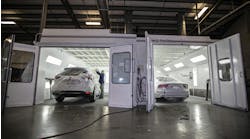The dos and don’ts of maximizing technician, service advisor production
It was a bright sunny Tuesday morning on the Southern California coast; the ocean was a perfect temperature and the waves were epic. Jim sat on his surfboard soaking in this special moment, as he had the beach and the ocean to himself. Jim loved surfing on Tuesday mornings because everyone else was at work — he had worked hard to get to this moment. During the past seven years Jim had been through 17 service advisors; there just seemed to be a shortage of good help these days. His goal was to build an auto repair shop that would allow him to make a nice six-figure income and give him the time freedom to go surf on Tuesday mornings. Prior to this moment every attempt at a Tuesday morning session would end in failure. There were the 1 -star reviews, the upset customers, the calls from a technician complaining about the advisors, the calls from the advisor complaining about the technician, and it all seemed to boil down to one thing poor communication. This would then lead to a lack of production and eventually poor financial performance for the business. Until one day Jim discovered the universal truths behind the dos and don’ts about maximizing technician and service advisor production.
Service advisors and technicians are human beings. In order to get results in work and life, all people utilize a behavioral strategy. Understanding that you are dealing with multiple personalities and deep-rooted behaviors is the first key to success. Each person on your team has unique talents, abilities, and their own set of behaviors they have learned throughout their life to generate the results that have made them successful. Successful shop owners and managers understand how to identify each team members unique behavioral approach and put them in the right position that enhances their natural talents. Jim discovered a system that allowed him to put his auto repair business on auto pilot. Here are the 6 keys Jim discovered that can help you and your shop become a profit generating machine!
-
Meet with each person individually – When Jim observed his team in action, he discovered there was friction between team members. At one point the negative atmosphere was so bad Jim sent everyone home for the day and locked the doors to the shop. The next day Jim came in and invested his time in meeting with each team member individually. The goal of the meeting was to help Jim understand what is important to each person. Through careful observation Jim discovered that each person on his team has unique wants and desires. During the meeting Jim ask thought provoking questions:
- “Why do you like working here?”
- “What do you like about your job?”
- “If I could help you achieve something in your personal life in the next 12 months what would that thing be?”
- “When would you like to retire? What type of retirement would you like to have? How can our shop and your job help you achieve that? Do you feel like we are making progress towards that now?”
After two full days of meetings with his team members, Jim was exhausted and excited! He learned so much about his employees and their personal goals. Jim felt closer to each person and vowed to utilize his time, effort, and expertise to help each of them reach their own personal goals. That was the turning point. The moral in the shop changed immediately as each person on the team began to elevate their performance in order to reach their own personal goals and team goals. Each person knew exactly what they were working for!
- Eliminate verbal communication – Jim began tracking and identifying the mistakes in the business that stole profits from the bottom line. What Jim discovered was a common factor that led to mistakes. Verbal Communication. When Jim analyzed comebacks, upset customers, and anything negative triggering event he discovered verbal communication was at the root of the problem. Many times, a service advisor would tell a technician to do something on a vehicle, the technician would perform the work and do what was she was told, however there were other items that needed addressing on the vehicle that were written on the repair order and they got overlooked. When the customer came in to pick up the vehicle the major part of the job was done, but the taillight, the windshield wiper, the sticky door would be left undone and the customer would be upset. This then created a panic at the last moment and the shop looked like a hornet’s nest that had just been hit with a baseball bat. Everyone was running around trying to fix the oversight. Jim decided that his customer deserved better than this and vowed to build a better system and eliminate the mistakes caused by relying solely on verbal communication.
- Build a solid written communication system that eliminates oversight and mistakes. There is power in the written word! The repair order holds the key to success for your shop! Jim made a policy change and helped each employee understand how to read the repair order. The promised time on the repair order was understood as a promise to the customer. Every client concern was written down as a separate job or labor line, even the smallest request. Over time the mistakes that were created by verbal communication disappeared and the team began to fire on all cylinders and execute to perfection. The technician’s productivity rates soared as they eliminated time wasters and unproductive actions.
- Huddles the key to engagement and effective execution. The team began to meet twice a day to gain an understanding of what was expected. Yes, there is a time for verbal communication, and it pays huge dividends. Morning huddles were utilized to help each technician understand what priorities the service office had for the day, review of incoming appointments, provide a platform for discussion of any roadblocks in production or diagnosis, and build team morale. At the end of the day the team would meet briefly before locking up to review the wins from the day and to plant the seeds of tomorrow. Jim could see the results of helping the technicians begin to plan their work a day in advance by reviewing the workflow plan for the next day, hidden obstacles would get caught early and the team was prepared to execute.
-
Speed – Learn to work in an efficient manner. Jim began to lead by example. After all his goal was to go surf on Tuesday morning. Jim bought a pair of ugly running shoes and began wearing them to work. When the team would ask him about his shoes, Jim replied with “oh, these? These are for running. I can get more done if I run around instead of walking.” Jim began running from his car to his office, if he helped a customer, he would run out to the car to get the information. Running is a powerful metaphor and it began to catch on, his team began to move and work with purpose. There were two other items Jim began to focus on with production:
- SOS – Speed of Service. How long did the average service take? How do we get faster? How do we get better? Jim would review the average Speed of Service KPI with his team every day.
- ATR – Actual time of repairs. Through effective communication the team created a new metric. The technicians would estimate how long a job would take them to complete. The advisors would track this and together the team would work on hitting this target. This helped the Service Advisors create accurate promised times and they now had a system for under promising and overdelivering.
- If it’s not perfect, it’s not right! Robert Hight of John Force Racing lost his first Funny Car Championship in 2008. The championship was in sight and Robert was one race away from hoisting the trophy. When describing the moment Robert talks about being ready for the moment and how time stood still, he knew he was going to win the race and the championship. The cars were staged, and they took off down the track, Robert nailed the start and was in the lead, he had a huge smile on his face as he knew he was going to win… until something in the engine came apart leading to a dramatic fireball and costing Robert the win and ultimately the championship. What is tragic about this story is that it could have been prevented. The cause of the failure was determined to be a 30-cent clip that was left off by a crew member. It was at this time that Robert and the team vowed to return next year and dominate the competition. In 2009 they did just that and they secured Robert’s first championship, taking the motto “if it’s not perfect it’s not right” every step of the way. What would happen if everyone in your shop adopted this motto and stuck to it every day? If every person involved in the customer experience worked with this mindset, it would change the quality of the experience and the finished product we deliver. It helped John Force Racing turn a defeat into a championship and it might just help you surf on Tuesday mornings.



